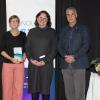December 10, 2010 - 7:20am
A team of students, graduates and faculty from Vancouver Island University fly to Honolulu, Hawaii next week to participate in one of the largest chemistry conferences in the world.
The Pacifichem conference is a major international conference held once every five years with over 10,000 delegates. There are over 13,000 research papers being presented in oral and poster format. The theme of the conference chemistry, technology and our global environment.
Four papers will be presented by VIU researchers from the Applied Environmental Research Labs (AERL) at the Nanaimo campus, all of which include contributions from undergraduate and graduate students.
“I’m definitely excited,” said Megan Willis, a fourth-year student at VIU with plans to pursue graduate studies in environmental chemistry. “Attending the conference is an invaluable experience. It will allow me to not only develop my presentation skills, but will also give me exposure to the many areas of active research in chemistry.”
Willis, who works as a student research assistant in the AERL, studies how chemical properties of contaminants affect the environment.
“My experience in the AERL has allowed me to practice ‘doing science’, which has greatly enhanced my undergraduate education,” said Willis, a two-time winner of the Undergraduate Student Research Award from the Natural Sciences and Engineering Research Council of Canada (NSERC).
“Participation in one of the largest international chemistry conferences in the world as an undergraduate student is a once-in-a- lifetime opportunity that would significantly enrich my research centered undergraduate experience at VIU.”
The title of Willis’s poster presentation is ‘Predicting contaminant diffusion and partitioning behaviours from time resolved membrane introduction mass spectrometry’ in a symposia titled Analytical and Environmental Chemistry in Human Health. This symposium will showcase recent advances in analytical developments and environmental research that impact human health.
“Megan’s research has increased our understanding of factors that control the transport and distribution of contaminants in the environment,” said chemistry professor Dr. Erik Krogh, co-director of the AERL with Dr. Chris Gill. “In addition to presenting her research, Megan will have the opportunity to attend talks by leading researchers in the field. The ability to participate in such a major conference is a rare and unique opportunity for an undergraduate student anywhere.”
Two VIU graduates, Cam Newhook and Nicholas Davey, will also attend the conference as part of the AERL team.
Newhook and Davey are both currently working on graduate degrees in Chemistry at the University of Victoria but conduct their research in the AERL. Another graduate student, Morten Martinsen visiting from the Norwegian University of Science and Technology, rounds out the AERL team.
Davey, Krogh and Gill will present papers at the conference, which showcase the work of student and graduate researchers.
“This is a great opportunity,” said Newhook, who’s research in the AERL has focused on measuring how fast specific contaminants form when disinfection products are added to treat drinking water. “I’m proud and excited to be part of the AERL research team.”
Meanwhile, Krogh and Gill recently received a $27,000 Discovery grant from NSERC to support undergraduate and graduate student research in analytical and environmental chemistry.
“Our research program in the AERL is focused on developing better, faster and cheaper measurement strategies and online analytical techniques for the direct and continuous monitoring of complex environmental samples in soil, water and air,” explained Dr. Chris Gill.
“The ability to monitor trace contaminants in real-time in environmental systems (e.g. indoor/outdoor air quality, drinking water disinfection by-products) is of paramount importance in understanding health risks and rapidly mitigating problems when they occur.
“Substantially faster chemical identification and quantification in complex samples also has direct application in emergency response scenarios, quality control and clinical diagnosis,” he said. “Consequently, our research program has direct significance for environmental quality and human health.”
Tags: In the Community





